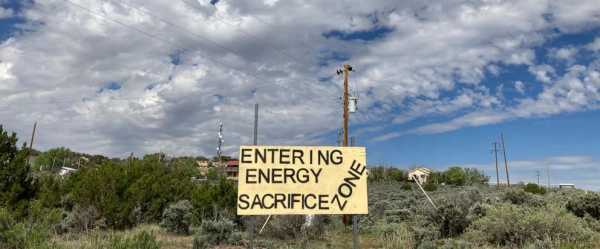
COUNSELOR, N.M. — Members of the Navajo community have complained to Samuel Sage for years about the noise and vibrations that rattle their homes.
They tell him about the dust kicked up by heavy trucks traveling the surrounding dirt roads and the smells that come from some of the oil and natural gas wells and tank batteries that dot the land around their Navajo community of Counselor in northwestern New Mexico.
On one day recently, Sage stood on a hill overlooking a public school that serves Counselor. He pointed to wells and tanks in the distance, painted green to blend in with juniper trees and sagebrush.
“Monitoring shows pollution heading either toward the school across the highway or toward the chapter depending on which way the wind is blowing,” he said.
Sage, the former president of the Navajo Chapter in Counselor and current community services coordinator, is among a group of residents and environmentalists who have sued New Mexico for allegedly failing to prevent pollution in northwestern and southeastern parts of the state.
About 144,000 people — 7% of the state’s population — live or attend a school or day care within a half-mile (0.80 kilometer) radius of oil and gas production, according to the lawsuit. The suit also states that almost all of the elementary, middle and high schools in the Hobbs district in Lea County as well as school districts in Eddy County are surrounded by oil and gas extraction and production sites on state, federal and private lands.
On Thursday, New Mexico Land Commissioner Stephanie Garcia Richard issued an executive order that includes a ban on all new oil and gas leases on state trust land within a mile (1.6 kilometers) of schools or other educational institutions, including day care centers, preschools and sports facilities that students use.
The order, which takes effect Thursday, also calls for her office — which oversees thousands of square miles (kilometers) of surface lands and mineral rights — to review all existing oil and gas leases on state trust land within a mile of schools to assess compliance with state regulations.
“We have an entire list of things we need to get through,” Garcia Richard said Thursday when asked about the review process. “It's a lot of work, and while we're prioritizing it's going to take us a while to get through the list.”
According to State Land Office estimates, there could be nearly 120 schools within one mile of oil and gas operations on federal, state, Tribal and private lands.
An Associated Press analysis of Oil Conservation Division and State Land Office data for active and new applications for permits to drill on state trust land found nearly 100 oil or gas wells within a mile of at least one school. That's out of more than 13,000 active and new oil and gas leases on state trust land.
The Hobbs School District has one of the highest concentrations of oil or gas wells located near school buildings, according to the analysis.
Hobbs is in the heart of the Permian Basin, one of the most prolific oil plays in the world. The revenue from development there is fueling record state spending on education and other social programs.
Hobbs Superintendent Gene Strickland said his district supports the industry.
“We do not feel the industry is harmful to the district by any proximity of oil and gas wells within the region,” he said. “The industry is made up of individuals who are members of our community. We share the same interests and also want nothing adverse to happen to the community we call home.”
Within a mile of Jefferson Elementary School on the west side of Hobbs are about 45 wells with active and new applications for permits to drill for oil on state trust land, according to the AP analysis. Heizer Middle School on the south side of Hobbs has 13. Those numbers increase when oil and gas wells outside state trust land are included.
To the north, Lybrook Elementary School near Counselor has 11 active oil wells on state trust land within a mile, according to the state data.
Felix Garcia, superintendent of the Jemez Mountain Public Schools, said the district opted to move the Lybrook school years ago since the previous campus was near a natural gas processing plant, and there were concerns about safety.
“I think it’s good that people are starting to raise some concerns because a lot of times nobody looks into it and then down the line you have health issues with the community,” Garcia said.
The Western Energy Alliance and other industry groups have argued that producers have been working with regulators and university researchers on drone and satellite technologies that allow for leaks to be more quickly detected and fixed, resulting in emission reductions despite increases in production.
Environmentalists argue that schools and public health can be protected by establishing setbacks or installing more equipment to reduce pollution. New Mexico currently has no setback requirements, although the state has adopted rules aimed at reducing methane emissions and other pollution from the industry.
It was not immediately clear how much revenue the state might have to forego by creating the new school buffer zones. Revenue that results from development on state trust land benefits public schools, universities, state hospitals and some water projects. In November, the State Land Office announced it had processed more than $300 million in oil and gas royalties for October, setting a new one-month record for the agency. Revenues for the last fiscal year topped a record $2.4 billion.
___
Keller reported from Albuquerque, New Mexico.
Sourse: abcnews.go.com






